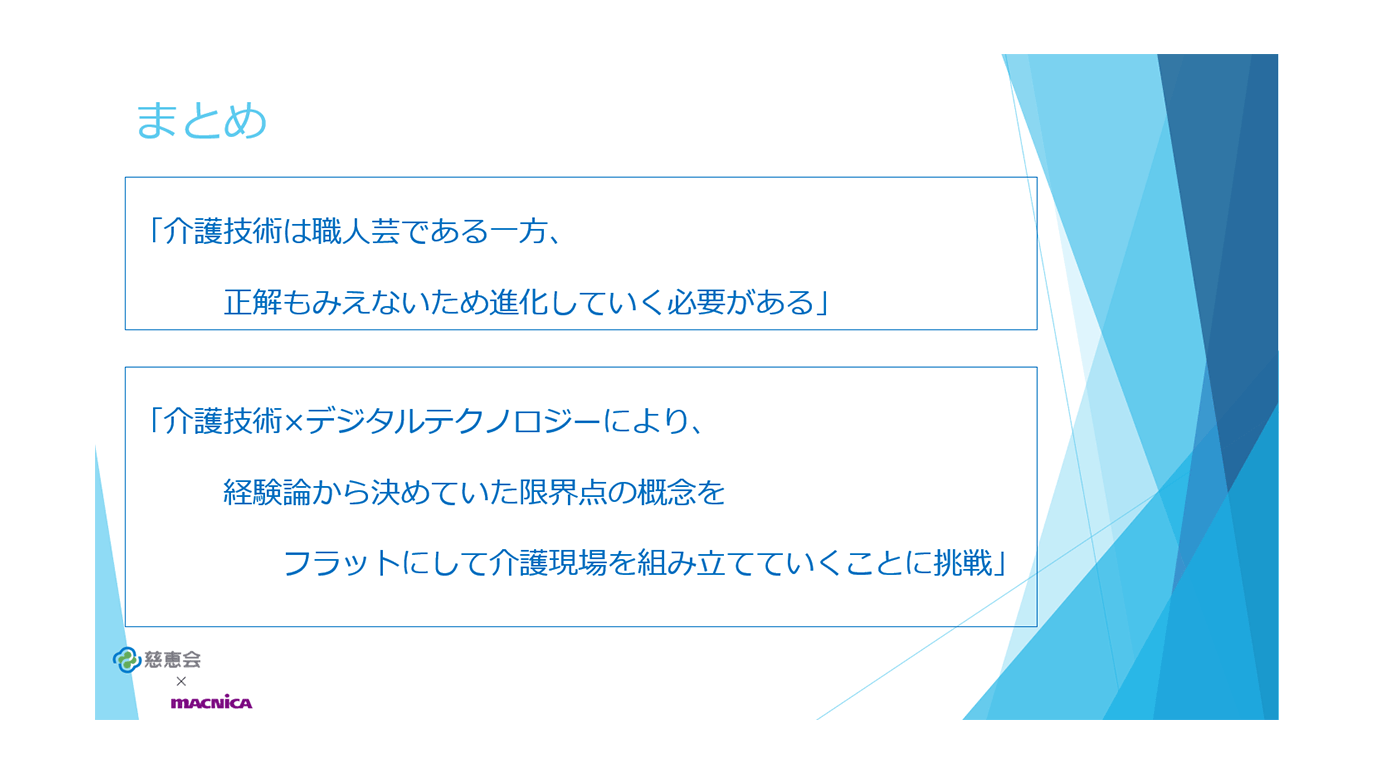![[Watching system] What is DX promoted by Jikeikai, which is changing nursing care from the northernmost tip of Honshu?](/business/healthcare/columns/hc/image/hc_nursing01_cover.jpg)
It goes without saying that the declining birthrate and aging population is a major social issue facing Japanese society. The nursing care industry, which is greatly affected by this, is facing realistic issues such as a shortage of 690,000 workers and an increase in social security costs of more than 10 trillion yen. In this article, we will introduce examples of efforts aimed at new nursing care by utilizing digital technology at the forefront of nursing care sites.
Mr. Chihiro Tanno, Chairman of Seishouen Association, and Mr. Kouhei Ono, General Manager of Seishoen, a unit-type long-term care health facility for the elderly, were invited to discuss initiatives to implement advanced technology in nursing care sites. and future prospects, we will deliver actual voices.
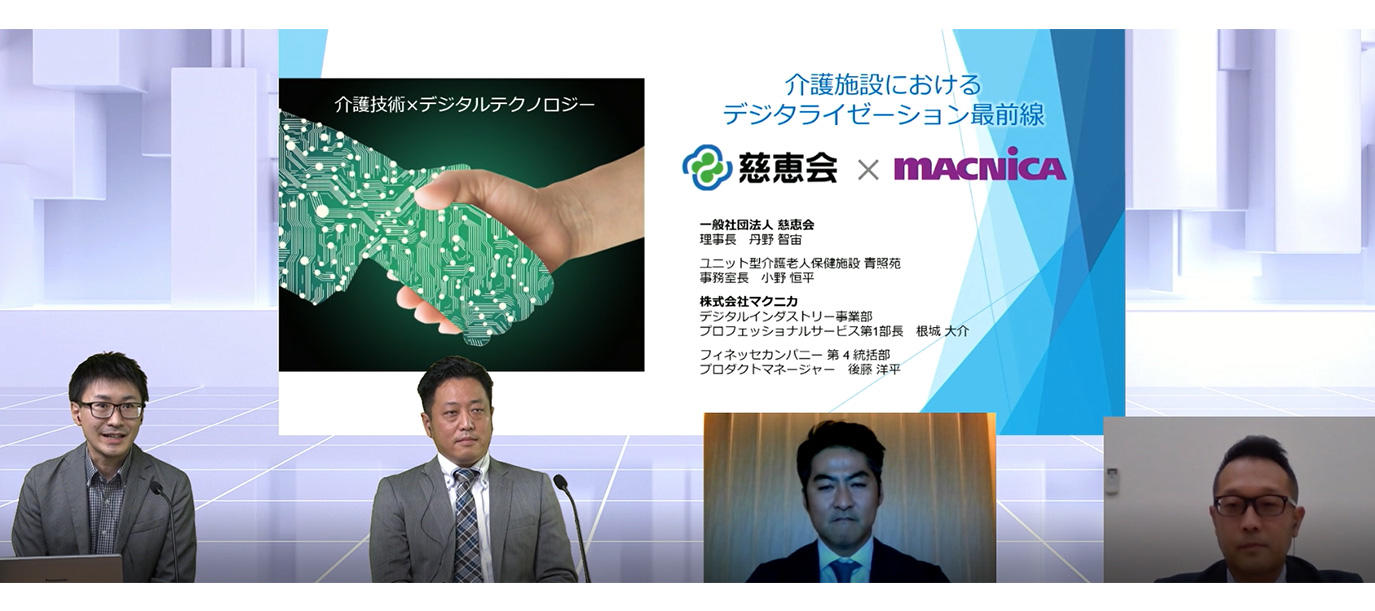
(From left: Macnica Goto and Nejo, Jikeikai Mr. Tanno and Mr. Ono)
Input and schedule optimization with the digital twin
Jikeikai is an incorporated association located in Aomori City that provides comprehensive medical, nursing care, and welfare services. The number of employees is 1,820. There are 4 medical institutions, 24 nursing care businesses, and a total of 1,110 beds. We monitor this 24 hours a day, 365 days a year.
Jikeikai, which has a vision of practicing community-based medical care and welfare, has decided to promote digitalization at the elderly health care facility "Seishouen" it operates. Mr. Tanno, the chairman of Seishouen, who actually worked as a caregiver at Seishoen 20 years ago, said that he started studying management from that time to improve the way caregivers work, and that he arrived at digitalization. “From the northernmost nursing care facility in Honshu, we embarked on digitization with the desire to somehow improve nursing care in Japan,” recalls Mr. Tanno.
Therefore, we decided to start with Seishouen, which is a unit type with all rooms being private rooms and is easy to promote digitalization. Seishouen, we decided to use digital technology for both bathing and sleeping. Let's start with the first bath.
The challenge with bathing was transporting users between the main building and the bathing building, which are connected by a corridor. Until then, the care leader had to grasp the situation of about 100 users, assign bathing methods and decide the order, and assign care staff to carry out bathing. They felt that they had reached their limit in continually thinking of ways to provide comfort for users and to prevent overtime work for staff.
Therefore, with the support of Macnica, they decided to use a digital twin with Siemens' "Plant Simulation" to optimize bathing schedules.
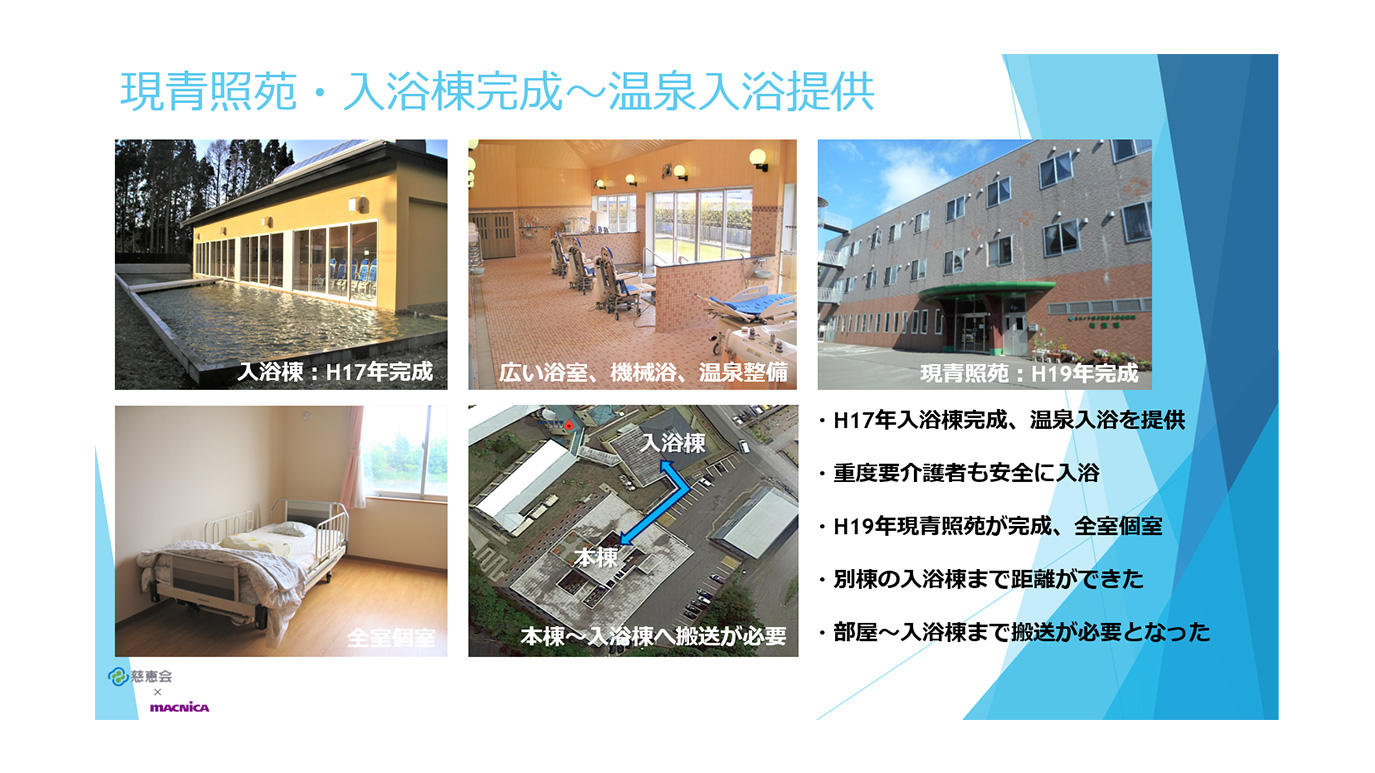
On-site employees use digital twins to solve problems
Plant Simulation is simulation software for the manufacturing industry that uses digital twins and is typically used to improve factory productivity. We applied this idea to the bathing process at Seishouen, created a digital nursing care facility on a PC, and prepared a system that simulates the bathing process.
We modeled data such as user attributes, facility equipment, staff shifts, etc., and digitized the know-how of nursing care leaders as much as possible. When we set the interval to start transportation to an overcrowded schedule, the waiting time of users became longer. Conversely, if the interval is lengthened, the waiting time will be shortened, but the work time required for bathing will be longer. In this way, we propose an appropriate schedule while adjusting the bathing order and interval time.
The point is that it is the staff of Seishouen on site who create the digital twin. As a result, when new issues arise, they will be able to solve them by themselves using the digital twin. For this reason, Seishouen staff receive monthly training on how to use Plant Simulation.
Plant Simulation is used not only for schedule optimization, but also for advance consideration of capital investment. With a digital twin, you can easily test how much time you can save by increasing the number of baths. For example, the current total bathing time is about 2.5 hours, but verification has shown that if we add one more special bath and one more linacita bath, it will be shortened to 1.7 hours.
“The greatest advantage of digitizing bathing operations is that we are now able to quantitatively understand operations,” says Mr. Ono, manager of Seishouen 's office. Mr. Ono says, "Because we are now able to visualize and share the feelings of each employee, it is useful for thinking about specific ways to improve efficiency."
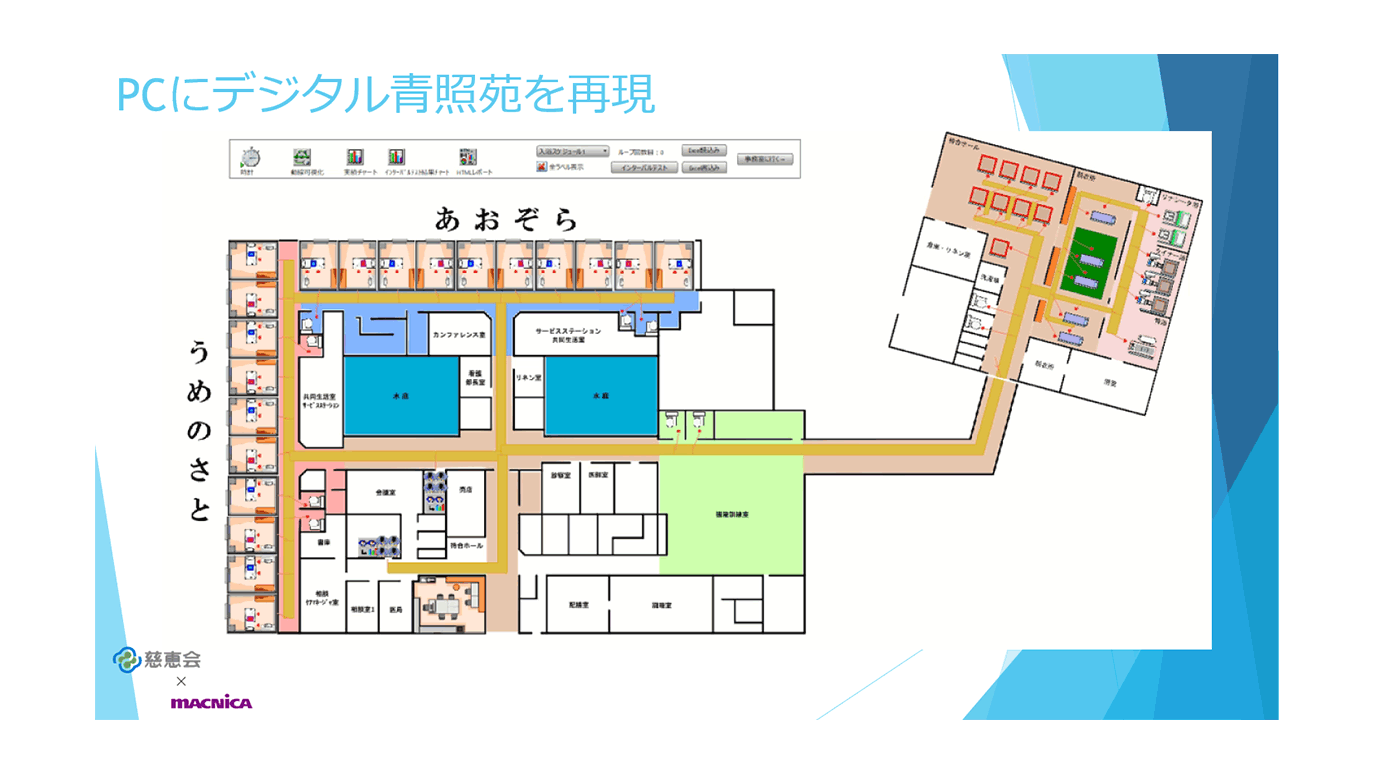
Converting sleep into data to achieve both greater efficiency and risk avoidance on site
The second sleep is part of the "remote monitoring" that we started to tackle the major issue of user risk management. It is a next-generation monitoring system that uses AI and the cloud, and combines a high-precision bed sensor with a proven track record overseas and a cloud-based dashboard.
Specifically, it is a solution that visualizes the user's condition in real time by installing a sensor under the mattress. In addition to obtaining information such as the presence or absence of getting out of bed, wakefulness/sleep status, heart rate, breathing rate, etc., alerts can be set for each item, so for example, it is possible to detect signs of falling as sensor alerts when getting out of bed. In addition, by setting the normal range values for heart rate and respiration and checking abnormal values with alerts, you can quickly respond to sudden changes.
This allows staff to know what the occupant is doing without having to visit the room. You can optimize the number of visits to the room, avoid the risk of contact, and at the same time manage risks such as sudden changes in condition.
Until now, staff would make rounds every hour during the night to visually check and ask whether users were sleeping properly. With the introduction of the system, we have been able to quantify sleep and understand what kind of sleep it is specifically. Since sleep conditions can be scored, it is now possible to understand life rhythms that cannot be known only by visual observation or listening.
It is said that by obtaining actual sleep data that could not be obtained by visual observation or hearing, efforts have begun to improve the quality of care itself.
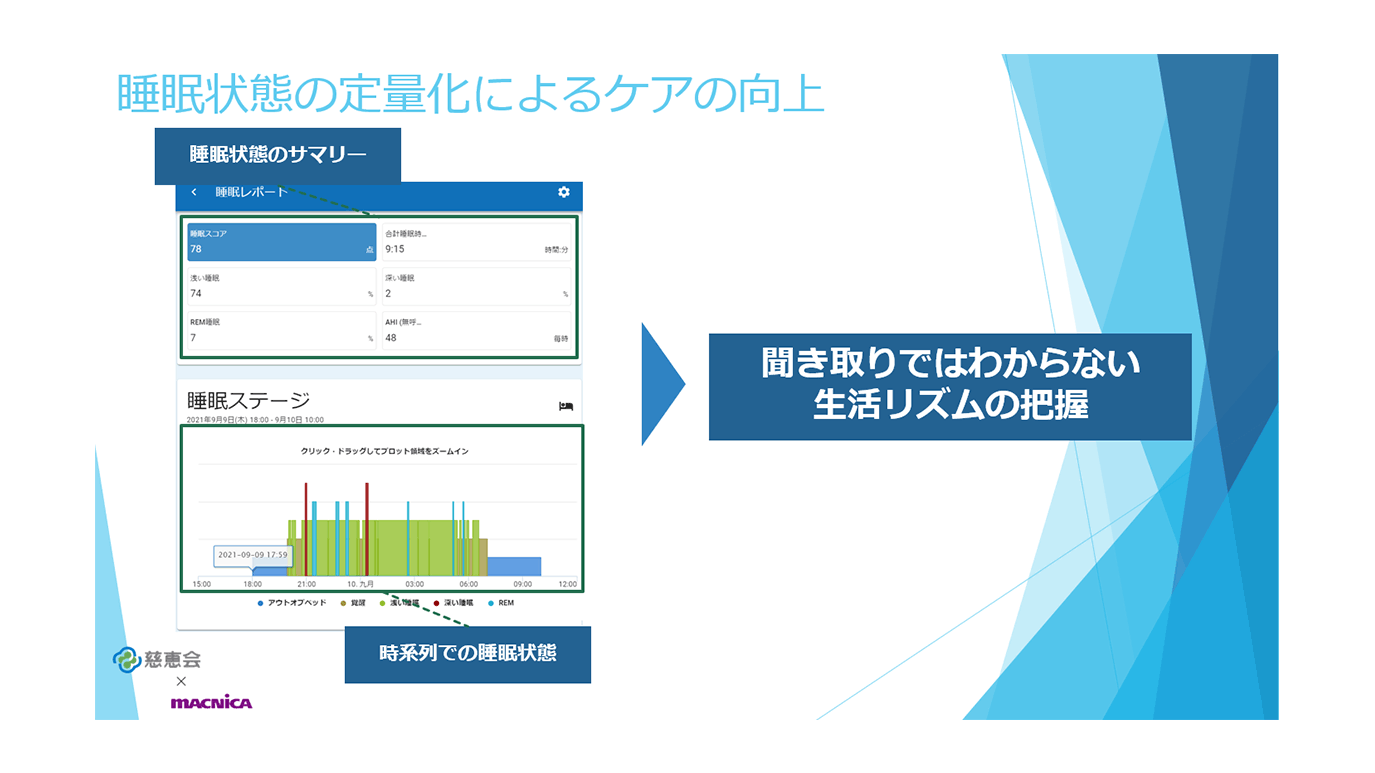
For example, by combining sleep data such as out of bed, REM sleep, or wakefulness with the number of falls, we can hypothesize that getting up to go to the bathroom from deep sleep may have led to falls. It seems to be related to As a result, focusing on sleep as a direction of care can lead to improvements in work such as reducing falls.
At the same time, we conducted a questionnaire survey of field staff to learn about the degree of adoption and issues, and also installed a monitor for checking the screen to further improve the effect.
Digitalization of Jikeikai just started
The digitization of Seishouen, which started at Seishoen, has just begun.
Mr. Tanno says that Jikeikai's idea of digitization is not about changing paper-based records to electronic ones, but about raising the level of on-site nursing care staff who have craftsmanship. In the area of optimizing the order of bathing, I think that in the future, by automatically creating a plan using AI, even new employees will be able to master it.
As for sleep, I would like to further investigate the sleep research of the elderly, such as the relationship with falls.
"I have high hopes for digitization, hoping that it will help prevent accidents in the elderly due to lack of sleep." (Mr. Tanno)
We also have high hopes for wearable devices that can collect data not only during sleep but also during waking hours.
“Recording is a burden in the field of nursing and nursing care. Body temperature, blood pressure, etc. are important data for the family, the person in question, and the government. It would be helpful if there was technology that automatically sent and entered periodically.” (Mr. Tanno)
He says that this will connect the "dots" of data as "lines", making the care provided by doctors, nurses, and caregivers even more meticulous. It is also hoped that by eliminating the time spent recording records, caregivers will be able to concentrate more on their primary duties.
Jikeikai's efforts, which started at the northernmost tip of Honshu, seem to be steadily changing the nursing care scene.
